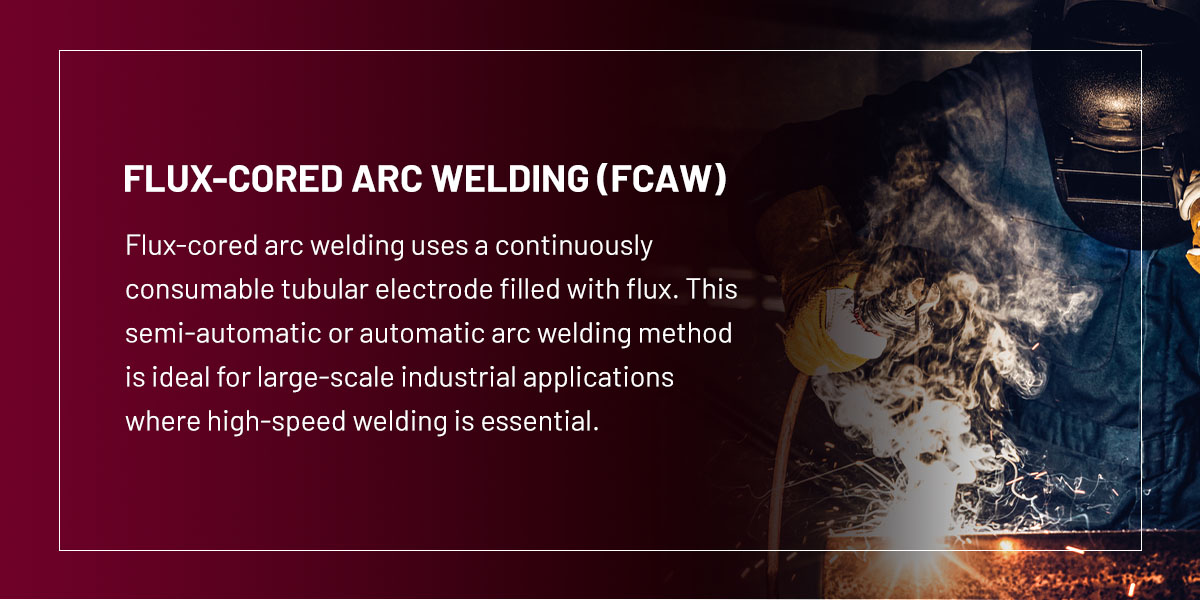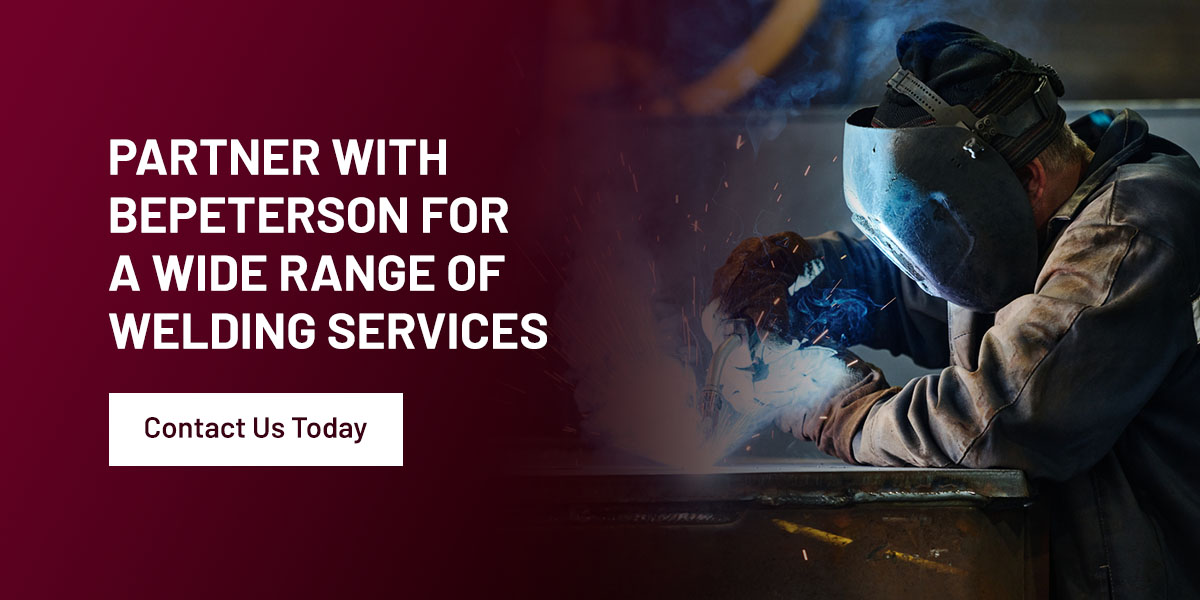Welding is a fundamental process in metalworking, performed by joining various types of metals and thermoplastics. It helps create strong and secure joints that are often superior to other methods of metal bonding. At BEPeterson, we specialize in various metal welding processes, from automatic and semi-automatic to manual welding equipment. This post introduces you to our welding processes and their unique advantages.
Different Types of Welding Processes
The following are methods of welding and types of techniques offered by BEPeterson:
1. Gas Metal Arc Welding (GMAW)
Gas metal arc welding, also known as metal inert gas (MIG) welding, is a semiautomatic welding process. In this process, a power supply and consumable wire electrode create an electric arc between the consumable wire electrode and the workpiece metals. The workpiece melts and fuses under the heat produced by the electric arc.
Advantages of GMAW welding include:
- Efficient weld penetration: GMAW provides strong welds with smaller sizes, making it ideal for applications that require precision. The ability to control the heat input allows you to weld thin materials without warping.
- Reduced fume production: Compared to other welding types, MIG welding generates less smoke and fumes to improve workplace air quality. This makes it a safe option for indoor workspaces.
- Speed and productivity: GMAW is known for its high welding speeds, which can increase your productivity. Its continuous wire feed allows you to weld without interruption, reducing downtime.
2. Gas Tungsten Arc Welding (GTAW)
Gas tungsten arc welding or tungsten inert gas (TIG) welding involves generating an electric current between a tungsten electrode and the metal being joined. A shielding gas is used around the weld to protect it from the surrounding environment. This welding process is used in aerospace industries or to weld thin workpieces of non-ferrous metals.
Advantages of TIG welding include:
- High-quality welds: TIG welding produces higher quality and visually appealing welds. The ability to control both the heat and the filler material allows for precise and clean welds, essential in high-stakes applications.
- Versatility: TIG welding is highly effective for welding thin sections of metals or various types of delicate workpieces, making it a favorite among skilled welders. It can be used on various metals, including aluminum, stainless steel and copper alloys.
- Control and precision: This method offers the welder greater control over the welding process, making it ideal for intricate designs and applications that require a high degree of precision.

3. Flux-Cored Arc Welding (FCAW)
Flux-cored arc welding uses a continuously consumable tubular electrode filled with flux. This semi-automatic or automatic arc welding method is ideal for large-scale industrial applications where high-speed welding is essential. FCAW is ideal for mild steel, high nickel alloys and stainless steel.
Advantages of FCAW welding include:
- High deposition rate: This technique allows for faster welding speeds, making it best suited for projects with tight deadlines. Its high deposition rate can improve your productivity, which is critical in high-demand manufacturing.
- Minimized porosity: FCAW reduces the risk of defects like porosity, providing stronger welds. The flux within the electrode helps protect the weld from atmospheric contamination, which can compromise the integrity of the joint.
- Versatility in positioning: FCAW can be used in various positions, whether flat, horizontal, vertical or overhead, making the welding method adaptable to various project requirements and environments.
4. Submerged Arc Welding (SAW)
Submerged arc welding is a fully mechanized technique in which an electric arc forms between a continuously supplied bare wire electrode and the material being welded. The arc and molten metal are submerged under a layer of granular flux, which also protects the weld from contamination. This method is commonly used for welding thicker sections of stainless steel, alloy steels and carbon-manganese steel.
Advantages of SAW welding include:
- High-quality welds with limited operator skill: SAW is designed to produce consistent, high-quality welds with minimal operator input. The automation involved can reduce the chances of human error, ensuring uniformity in large production runs.
- Capability for thick materials: This method excels at welding thicker materials, making it ideal for heavy industrial applications. Its ability to produce deep weld penetration ensures strong joints in demanding applications.
- Reduced fume and noise levels: Since the welding arc is submerged, SAW produces minimal fumes and noise, creating a safer, more comfortable worksite.
How to Choose the Right Welding Technique
You’ll need to use the right welding techniques to ensure a successful project. Consider these factors when choosing between the different welding processes:
- Material to be welded: Different welding processes work better on different types of materials. For instance, GTAW works well with titanium and other exotic metals, while FCAW does best when welding thicker, stronger materials.
- Welding position: Consider that some welding processes work best in specific positions. For example, SMAW is suitable for welding in any position, while GMAW is ideal for flat and horizontal welding.
- Welding speed: Welding speed can impact the production rate and the cost of your project. For example, GMAW has a high welding speed, while GTAW is slower.
- Welding quality: The quality of the weld is an essential factor to consider, as it affects the durability and safety of your finished product. For instance, GTAW can produce high-quality, robust welds with excellent appearance and penetration.
- Cost: Cost is an essential aspect of any project. The cost of welding can vary depending on the process you choose, the equipment required and any labor costs.
Partner With BEPeterson for a Wide Range of Welding Services
The welding process is critical for any industrial fabrication project. Hence, it’s important to understand their basic differences so you can choose the right methods for your needs. All welding operations at BEPeterson conform to ASME Sect 9 and AWS D1.1 and D1.6 standards. Our well-equipped facility allows us to take on diverse, complex projects and meet a wide range of customer requirements. We are your one-stop shop for fabrication services, helping you create quality welds and enhance your operations.
Contact us today to get started on your next project.


